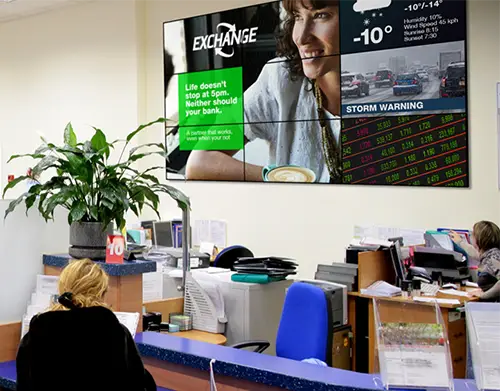Digital Signage Explained:
How It Works, Key Technologies, and Business Benefits
Digital signage is revolutionizing the way information and advertisements are presented, bringing an interactive and engaging twist to traditional methods. This guide aims to simplify the workings of digital signage, blending sophisticated technology with intuitive processes for a broader audience.
Understanding Digital Signage Fundamentals
Digital signage relies on three main components: the digital screens where content is displayed, the media players that send content to those screens, and a content management system (CMS) that oversees what and when content is displayed. These elements are utilized across various settings, including retail, corporate, educational, and public spaces, to deliver dynamic content.
The Core Components: Screens, Media Players, and CMS
- Digital Displays: These are the actual screens where content comes to life, using technologies such as LCD or LED to exhibit everything from ads to information. Depending on their location (indoor or outdoor), these screens are designed with specific features like size, brightness, and resolution in mind.
- Media Players: Acting as the conduit between the CMS and the displays, media players decode and render the content onto the screens. They can be integrated within the displays or function as separate units, providing the flexibility needed for various setups.
- Content Management System (CMS): The CMS is essentially the control hub for digital signage, enabling users to upload, schedule, and manage content remotely. With advancements in technology, CMS platforms have become more user-friendly, offering drag-and-drop functionalities and extensive scheduling options.
The Workflow: Bringing Digital Signage to Life
- Content Creation: This initial step involves generating or obtaining the content, designed to capture attention and effectively communicate messages. This can be performed using purpose-built design software or directly within most modern CMS applications.
- Content Management: After creation, content is uploaded to the CMS for organization and scheduling. This step allows for precise control over what content is displayed and when, ensuring relevancy for the target audience.
- Deployment: Through either wired or wireless/cellular connections, the CMS transmits the content to the media players, which then display it on the screens. This seamless connectivity ensures that content can be updated and displayed in real time.
- Interactivity and Updates: Modern digital signage systems often feature interactive elements, such as touchscreens or QR codes, enhancing user engagement. The CMS's ability to integrate with live data feeds enables the display of real-time information, keeping content fresh and relevant.
- Performance Monitoring: An essential aspect of digital signage is the capability to monitor and analyze system performance and viewer engagement. This feedback loop helps in refining content strategies and ensuring optimal functionality of the signage network.
- Cloud-Based Solutions: Leveraging cloud technology and Software as a Service (SaaS) models, digital signage platforms offer scalability, ease of access, and cost efficiency. Cloud integration ensures that the system is always equipped with the latest features and security updates.

Why Digital Signage Is Effective
By harnessing cutting-edge technology and streamlined content management, digital signage offers a compelling way to engage and inform audiences. From the initial setup to the ongoing content delivery, each phase is crucial for creating impactful visual experiences. It’s an innovative approach that enables businesses to communicate more effectively, offering content that’s not just informative but also engaging and interactive.
Embracing Digital Signage for Your Business
Digital signage is transforming communication, making it more dynamic and interactive. For businesses looking to explore the potential of digital signage or seeking to enhance their current systems, resources like MediaTile provide valuable insights and tailored solutions. By understanding and utilizing digital signage effectively, businesses can unlock new ways to connect with their audience.





